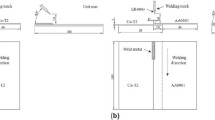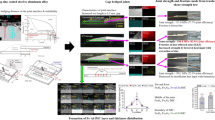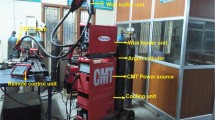Abstract
This study compares the electrically assisted pressure joining (EAPJ) performances of two non-ferrous alloys, aluminum (Al) 6061-T6 and copper (Cu) C11000. For joining, two cylindrical specimens with identical geometries are assembled in a longitudinal direction. Electric currents with various electric current densities are applied directly to the specimen assemblies during continuous axial plastic deformation. Microstructural analysis confirms that the joints are successfully fabricated without melting and solidification in both material combinations. While the mechanical properties of the joints are strongly affected by the electric current density, the results also show that both joining temperature and amount of plastic deformation for successful EAPJ of the C11000 alloy are much lower than those of the Al 6061-T6 alloy. In EAPJ, the Cu C11000 even can be joined at a temperature (250 °C) lower than the 0.3–0.7Tm range (Tm: the melting temperature of material), while the Al 6061-T6 requires the joining temperature (450 °C), which is about 0.7Tm for that material. The present study confirms that the process parameters for successful EAPJ can strongly differ depending on the metal alloy.











Similar content being viewed by others
Data Availability
The raw/processed data required to reproduce these findings cannot be shared at this time as the data are part of an ongoing study.
References
Liu, L., Ren, D., & Liu, F. (2014). A review of dissimilar welding techniques for magnesium alloys to aluminum alloys. Materials, 7(5), 3735–3757. https://doi.org/10.3390/ma7053735
Sahin, M. (2010). Joining of aluminium and copper materials with friction welding. International Journal of Advanced Manufacturing Technology, 49(5–8), 527–534. https://doi.org/10.1007/s00170-009-2443-7
Sahoo, A., & Tripathy, S. (2019). Development in plasma arc welding process: A review. Materials Today: Proceedings, 41, 363–368. https://doi.org/10.1016/j.matpr.2020.09.562
Liu, F., Chen, T., Pang, L., Song, K., & Wu, Y. (2022). Study on Electro-Spark Deposition Welding of Ultra-thin Sheet of Ti-6.5Al-1Mo-1 V-2Zr Alloy. International Journal of Precision Engineering and Manufacturing, 23(10), 1203–1210. https://doi.org/10.1007/s12541-022-00699-y
Wang, P., Chen, X., Pan, Q., Madigan, B., & Long, J. (2016). Laser welding dissimilar materials of aluminum to steel: An overview. International Journal of Advanced Manufacturing Technology, 87(9–12), 3081–3090. https://doi.org/10.1007/s00170-016-8725-y
Kwak, Y., Kang, T., Lee, S. H., & Kang, M. (2023). Effects of Laser and Tungsten Arc Welding Processes on the Thermal Softening and Mechanical Properties of Almag6 Aluminum Alloy. International Journal of Precision Engineering and Manufacturing, 24(4), 531–536. https://doi.org/10.1007/s12541-023-00772-0
Ueda, Y., Murakawa, H., & Ma, N. (2012). Introduction to Welding Mechanics. In Welding Deformation and Residual Stress Prevention. https://doi.org/10.1016/b978-0-12-394804-5.00001-3
Atabaki, M. M., Nikodinovski, M., Chenier, P., Ma, J., Harooni, M., & Kovacevic, R. (2014). Welding of Aluminum Alloys to Steels: An Overview. Journal for Manufacturing Science and Production, 14(2), 59–78. https://doi.org/10.1515/jmsp-2014-0007
Zhao, S., & Li, Y. (2023). Numerical Analysis of Welding Direction and Sequence for Controlling Distortion and Residual Stress in Aluminum Plate-Sleeve Structures. International Journal of Precision Engineering and Manufacturing, 24(6), 1011–1031. https://doi.org/10.1007/s12541-023-00794-8
Mohamed, H. A., & Washburn, J. (1975). Mechanism of Solid State Pressure Welding. Welding Journal (Miami, Fla), 54(9), 302–310.
Kang, J. W., Zhang, S., Bui Thi, T. A., Hong, S. T., Lee, S., & Han, H. N. (2023). Friction-Assisted Dissimilar Solid State Lap Joining of Aluminum and Copper Pipes. International Journal of Precision Engineering and Manufacturing, 24(2), 199–208. https://doi.org/10.1007/s12541-022-00745-9
Kim, G. W., Song, K. H., & Jeong, S. M. (2022). Realization of Enhanced Mechanical Properties of Solid-State Welded Ti Alloy with Commercial Purity. International Journal of Precision Engineering and Manufacturing, 23(5), 471–477. https://doi.org/10.1007/s12541-022-00633-2
Laska, A., Szkodo, M., Pawłowski, Ł, & Gajowiec, G. (2023). Corrosion Properties of Dissimilar AA6082/AA6060 Friction Stir Welded Butt Joints in Different NaCl Concentrations. International Journal of Precision Engineering and Manufacturing - Green Technology, 10(2), 457–477. https://doi.org/10.1007/s40684-022-0441-z
Basak, S., Mondal, M., Gao, K., Hong, S. T., Anaman, S. Y., & Cho, H. H. (2022). Friction stir butt-welding of roll cladded aluminum thin sheets: effect of microstructural and texture changes on mechanical properties. Materials Science and Engineering: A, 832, 142490. https://doi.org/10.1016/j.msea.2021.142490
Hammood, A. S., Esmailzadeh, M., Hosseini, S. N., Karimi, S., Calliari, I., Pezzato, L., & Brittain, R. (2023). Effect of Friction Stir Welding Parameters on Microstructure and Corrosion Behavior of 2101 Duplex Stainless Steel in Simulated Body Fluid. International Journal of Precision Engineering and Manufacturing - Green Technology, 10(2), 327–337. https://doi.org/10.1007/s40684-022-00440-0
Kim, M. J., Yoon, S., Park, S., Jeong, H. J., Park, J. W., Kim, K., Jo, J., Heo, T., Hong, S. T., Cho, S. H., Kwon, Y. K., Choi, I. S., Kim, M., & Han, H. N. (2020). Elucidating the origin of electroplasticity in metallic materials. Applied Materials Today, 21, 100874. https://doi.org/10.1016/j.apmt.2020.100874
Lupi, S., Forzan, M., & Aliferov, A. (2015). Analytical and Numerical Methods for Calculation of Induction and Conduction Heating Systems. In Induction and Direct Resistance Heating. https://doi.org/10.1007/978-3-319-03479-9_5
Park, J. W., Jeong, H. J., Jin, S. W., Kim, M. J., Lee, K., Kim, J. J., Hong, S. T., & Han, H. N. (2017). Effect of electric current on recrystallization kinetics in interstitial free steel and AZ31 magnesium alloy. Materials Characterization, 133(September), 70–76. https://doi.org/10.1016/j.matchar.2017.09.021
Nguyen, T. A. N., Choi, H., Kim, M. J., Hong, S. T., & Han, H. N. (2022). Evaluation of Efficiency of Electrically Assisted Rapid Annealing Compared to Rapid Induction Heat Treatment. International Journal of Precision Engineering and Manufacturing - Green Technology, 9(2), 485–492. https://doi.org/10.1007/s40684-021-00382-z
Ben, D. D., Yang, H. J., Ma, Y. R., Shao, X. H., Pang, J. C., & Zhang, Z. F. (2018). Rapid hardening of AISI 4340 steel induced by electropulsing treatment. Materials Science and Engineering A, 725(January), 28–32. https://doi.org/10.1016/j.msea.2018.04.013
Zeng, B., Yan, X., Xie, Z., Liu, J., Wang, J., Huang, K., & Yang, Y. (2023). Plastic Deformation Mechanism of the Ti6Al4V Micro-gear Formed Under an Electrical Field. International Journal of Precision Engineering and Manufacturing - Green Technology, 11(1), 107–122. https://doi.org/10.1007/s40684-023-00536-1
Jeong, H. J., Kim, M. J., Choi, S. J., Park, J. W., Choi, H., Luu, V. T., Hong, S. T., & Han, H. N. (2020). Microstructure reset-based self-healing method using sub-second electric pulsing for metallic materials. Applied Materials Today, 20, 100755. https://doi.org/10.1016/j.apmt.2020.100755
Jeong, K., Jin, S.-W., Kang, S.-G., Park, J.-W., Jeong, H.-J., Hong, S.-T., Cho, S. H., Kim, M.-J., & Han, H. N. (2022). Athermally Enhanced Recrystallization Kinetics of Ultra-Low Carbon Steel via Electric Current Treatment. Acta Materialia, 232, 117925. https://doi.org/10.1016/j.actamat.2022.117925
Zhang, S., Cai, L., Nguyen, T. A. N., Geng, M., Gao, K., Hong, S. T., & Kim, M. J. (2023). Effects of Intermetallic Evolution by Electrically Assisted Rapid Heat Treatment on the Mechanical Performance and Formability of Aluminum Clad Steel. International Journal of Precision Engineering and Manufacturing - Green Technology, 10(2), 367–379. https://doi.org/10.1007/s40684-022-00460-w
Li, Y. F., Das, H., Hong, S. T., Park, J. W., & Han, H. N. (2018). Electrically assisted pressure joining of titanium alloys. Journal of Manufacturing Processes, 35(June), 681–686. https://doi.org/10.1016/j.jmapro.2018.09.015
Zhang, S., Gao, K., Hong, S. T., Ahn, H., Choi, Y., Lee, S., & Han, H. N. (2021). Electrically assisted solid state lap joining of dissimilar steel S45C and aluminum 6061–T6 alloy. Journal of Materials Research and Technology, 12, 271–282. https://doi.org/10.1016/j.jmrt.2021.02.091
Akmal, M., et al. (2024). Achieving Superior Strength and Elongation from Electrically Assisted Pressure Joining of Medium Entropy Alloy and Ti-6Al-4V. Scripta Materialia, 239(September 2023), 115781. https://doi.org/10.1016/j.scriptamat.2023.115781
Hong, S. T., Li, Y. F., Park, J. W., & Han, H. N. (2018). Effectiveness of electrically assisted solid-state pressure joining using an additive manufactured porous interlayer. CIRP Annals, 67(1), 297–300. https://doi.org/10.1016/j.cirp.2018.04.062
Zhang, S., Van Loi, T., Boakye, S. Y., Anaman, S. Y., Cai, L., Gao, K., Hong, S. T., Cho, H. H., & Kim, D. H. (2022). Effectiveness of an additively manufactured porous layer in dissimilar solid-state bulk joining of additively manufactured maraging steel and conventional AISI410 steel. Additive Manufacturing, 49(November), 102508. https://doi.org/10.1016/j.addma.2021.102508
Anh, T., Nguyen, N., Basak, S., Zhang, S., Thuong, T., & Mounarik, D. (2022). Electrically assisted pressure joining of thin bi ‑ layer aluminum ‑ clad aluminum sheets. The International Journal of Advanced Manufacturing Technology, 4713–4723. https://doi.org/10.1007/s00170-022-09687-y
Lee, S., et al. (2024). Development of Functionally Graded Austenitic Lightweight Steel through Electrically Assisted Pressure Solid-State Joining. Materials Science and Engineering: A, 891(September 2023), 146003. https://doi.org/10.1016/j.msea.2023.146003
Do, T. T., Lee, S., Tu, T., Bui, A., Anh, T., Nguyen, N., Lee, J., Han, H. N., & Hong, S. (2022). Simultaneous Joining and Forming of Dissimilar Steels by Electrically Assisted Pressure Joining., 2200256, 1–8. https://doi.org/10.1002/srin.202200256
Khan, H. A., Asim, K., Akram, F., Hameed, A., Khan, A., & Mansoor, B. (2021). Roll bonding processes: State-of-the-art and future perspectives. Metals, 11(9), 1344. https://doi.org/10.3390/met11091344
Vural, M. (2014). Welding Processes and Technologies. In Comprehensive Materials Processing (Vol. 6). Elsevier. https://doi.org/10.1016/B978-0-08-096532-1.00603-8
Zhang, J. Y., Sun, M. Y., Xu, B., Hu, X., Liu, S., Xie, B. J., & Li, D. Z. (2019). Evolution of the interfacial microstructure during the plastic deformation bonding of copper. Materials Science and Engineering A, 746(November 2018), 1–10. https://doi.org/10.1016/j.msea.2018.12.119
Huang, Y., Ridley, N., Humphreys, F. J., & Cui, J. Z. (1999). Diffusion bonding of superplastic 7075 aluminium alloy. Materials Science and Engineering A, 266(1–2), 295–302. https://doi.org/10.1016/s0921-5093(98)00958-7
Alhazaa, A., Haneklaus, N., & Almutairi, Z. (2021). Impulse pressure-assisted diffusion bonding (IPADB): Review and outlook. Metals, 11(2), 1–9. https://doi.org/10.3390/met11020323
Shabani, A., Bagheri, A., Toroghinejad, M. R., & Cavaliere, P. (2024). Texture Evolution and Hardening Behavior of Al/IF Composite Produced through Severe Plastic Deformation. Materials Science and Engineering: A, 889(November 2023), 145816. https://doi.org/10.1016/j.msea.2023.145816
Deshpande, A., Tofangchi, A., & Hsu, K. (2019). Microstructure evolution of Al6061 and copper during ultrasonic energy assisted compression. Materials Characterization, 153(April), 240–250. https://doi.org/10.1016/j.matchar.2019.05.005
Pelleg, J. (2016). Diffusion in dislocations. Solid Mechanics and Its Applications, 221, 87–94. https://doi.org/10.1007/978-3-319-18437-1_8
Ha, C., Bohlen, J., Yi, S., Zhou, X., Brokmeier, H. G., Schell, N., Letzig, D., & Kainer, K. U. (2019). Influence of Nd or Ca addition on the dislocation activity and texture changes of Mg–Zn alloy sheets under uniaxial tensile loading. Materials Science and Engineering A, 761(June), 138053. https://doi.org/10.1016/j.msea.2019.138053
Rui, S. S., Han, Q. N., Wang, X., Li, S., Ma, X., Su, Y., Cai, Z., Du, D., & Shi, H. J. (2021). Correlations between two EBSD-based metrics Kernel Average Misorientation and Image Quality on indicating dislocations of near-failure low alloy steels induced by tensile and cyclic deformations. Materials Today Communications, 27(April), 102445. https://doi.org/10.1016/j.mtcomm.2021.102445
Acknowledgements
This work was supported by National Research Foundation of Korea (NRF) grant funded by the Korea government (MSIT) (No. 2019R1A2C2009939, 2021R1A2C3005096). This work was also supported by "Regional Innovation Strategy (RIS)" through the National Research Foundation of Korea (NRF) funded by the Ministry of Education (MOE)(2021RIS-003).
Author information
Authors and Affiliations
Corresponding author
Ethics declarations
Competing Interest
The authors report no conflict of interest.
Additional information
Publisher's Note
Springer Nature remains neutral with regard to jurisdictional claims in published maps and institutional affiliations.
Rights and permissions
Springer Nature or its licensor (e.g. a society or other partner) holds exclusive rights to this article under a publishing agreement with the author(s) or other rightsholder(s); author self-archiving of the accepted manuscript version of this article is solely governed by the terms of such publishing agreement and applicable law.
About this article
Cite this article
Bui-Thi, TA., Do, T.T., Zhang, S. et al. Comparative Study of Electrically Assisted Pressure Joining of Aluminum 6061-T6 Alloys and Copper C11000 Alloys. Int. J. of Precis. Eng. and Manuf.-Green Tech. (2024). https://doi.org/10.1007/s40684-024-00617-9
Received:
Revised:
Accepted:
Published:
DOI: https://doi.org/10.1007/s40684-024-00617-9




